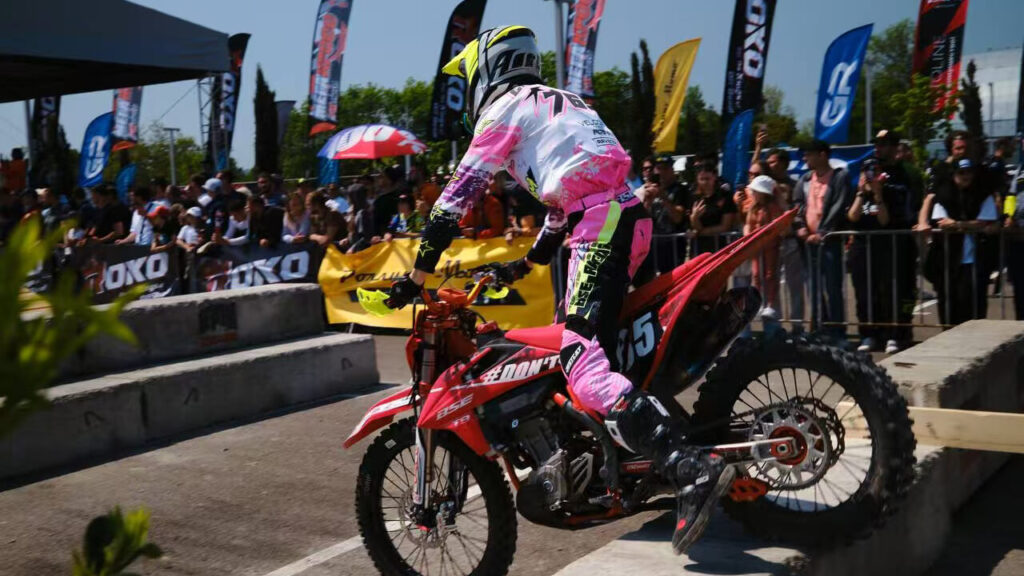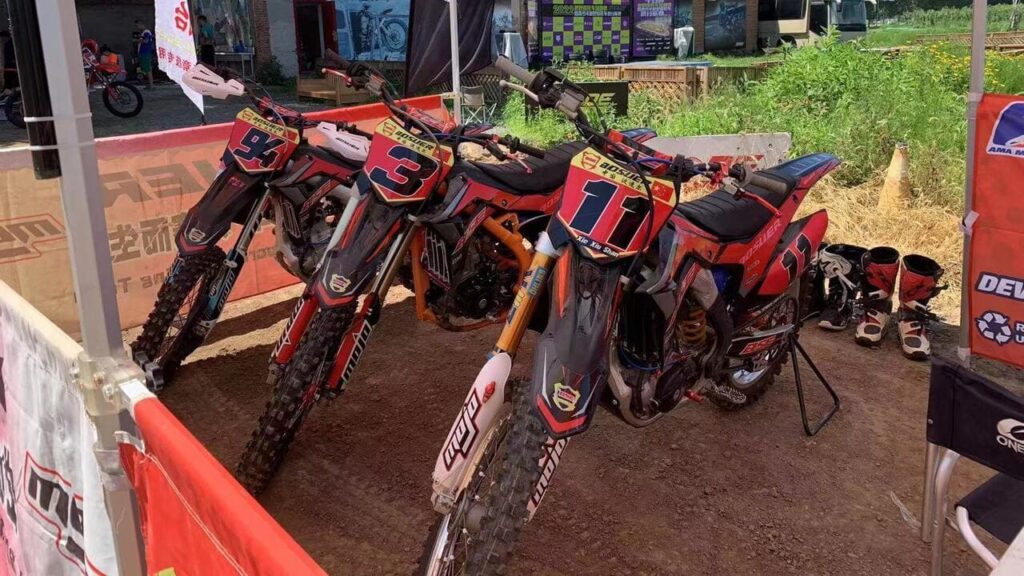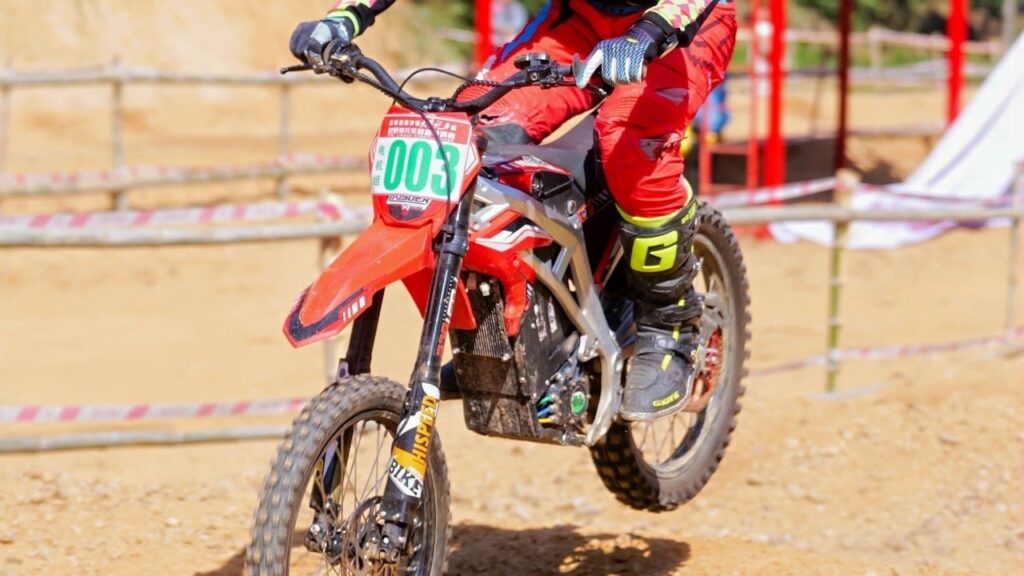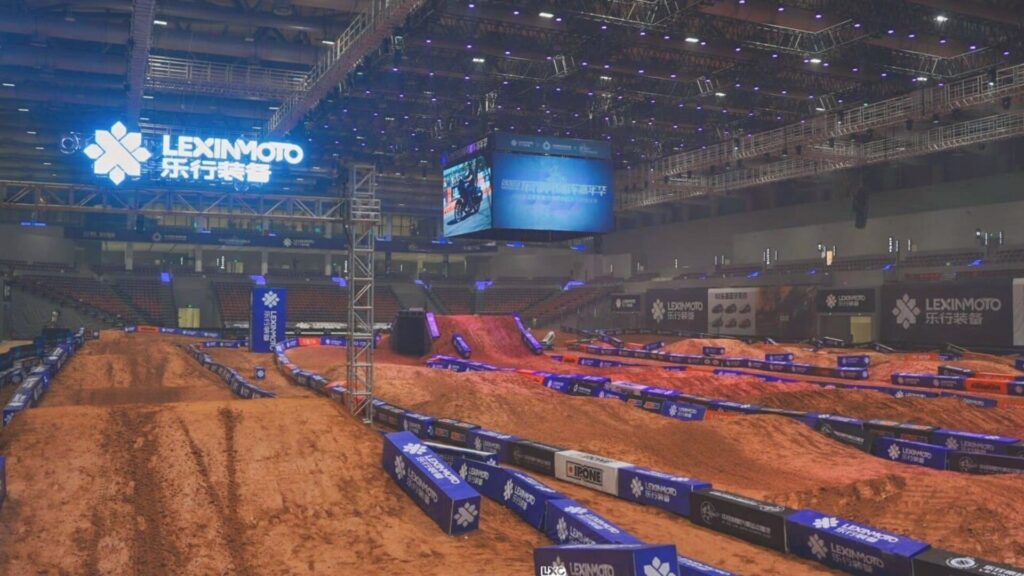Table des matières
BasculerQu'est-ce que le motocross exactement ?
Avez-vous déjà vu une moto tout-terrain voler comme si elle avait des ailes ? C'est ça le motocross. Un instant, le pilote s'élance d'un saut, l'instant d'après, il dérape dans un virage comme s'il patinait sur du gravier. C'est bruyant, c'est salissant et c'est complètement addictif.
Les pistes ? Un chaos total, dans le meilleur sens du terme. Certaines sont construites à flanc de colline, d'autres sont artificielles, avec des sauts qui ressemblent à de petites falaises. Il y a des virages serrés, de la terre meuble, des ornières plus profondes que vos bottes. Ce n'est pas une promenade de santé. Et c'est pour ça que les gens l'adorent.
Je me souviens de la première fois que j'ai regardé une course : j'étais stupéfait par la vitesse à laquelle ils allaient. Les motos semblaient presque toujours à plat. Ce n'est pas seulement une question de vitesse. C'est une question de contrôle, de sang-froid, et de savoir quand accélérer à fond et quand freiner à fond.
Le motocross est-il un vrai sport ?
Certains en rient, comme si ce n'étaient que des gars qui jouent dans la boue. C'est normal, jusqu'à ce qu'on essaie. On réalise alors à quel point c'est brutal. Il faut s'accrocher à une machine qui essaie de nous déstabiliser à chaque seconde, tout en essayant de surpasser 20 autres pilotes.
Il ne s'agit pas seulement de tourner la poignée de gaz. Les pilotes s'entraînent comme des athlètes, car ce sont des athlètes. Il faut des jambes solides, une adhérence inébranlable et une concentration extrême. Si vous ratez un virage, vous vous retrouverez tête la première dans la poussière, avec un peu de chance.
Il y a des règles, des championnats du monde, des équipes nationales, tout le tralala. La FIM organise les courses mondiales, et croyez-moi, personne ne décerne de trophées simplement pour une participation. Si vous pensez que ce n'est pas un vrai sport, vous n'avez probablement jamais assisté à un seul départ en personne. C'est le chaos. Un chaos magnifique.
Les origines du motocross, alimentées par la terre
Le motocross a des racines anciennes. Genre, en 1906. À l'époque, au Royaume-Uni, des pilotes sur des motos encombrantes se lançaient dans des courses de côtes : boue, rochers, sans véritable règle. Seul le premier arrivé était le premier. Les motos n'avaient rien à voir avec celles d'aujourd'hui : elles tombaient en panne, surchauffaient et rebondissaient comme des bâtons sauteurs.
Le nom est venu plus tard. « Moto » pour moto. « Cross » pour cross-country. Simple. Il s'est rapidement répandu en Europe, puis a franchi l'Atlantique pour atteindre les États-Unis dans les années 70. C'est à ce moment-là que le sport a véritablement pris son essor : grands événements, équipes d'usine, fans remplis dans les tribunes.
Et les vélos ? Ils sont devenus plus rapides, plus légers, plus précis. Mais l'essentiel est resté le même : le cycliste contre le terrain, la machine contre la gravité. Cet aspect n'a jamais changé.

Les meilleurs événements de motocross à travers le monde
C'est indéniable : le motocross a pris de l'ampleur. Ce qui n'était au départ qu'un sport de niche est devenu un sport suivi par des fans sur tous les continents. Et ce n'est pas seulement une question de franchir la ligne d'arrivée en premier. Les plus grands événements de ce sport façonnent l'entraînement des pilotes, la construction des motos et la passion des fans pour ce sport.
Les deux grands : MXGP et AMA
Demandez à n'importe quel pilote vétéran, et il nommera probablement deux championnats qui ont façonné sa carrière : le MXGP et les AMA Nationals. Championnat du monde de motocross FIM Le MXGP existe depuis le début des années 50. Il se déroule principalement en Europe, mais la série se déplace partout, des pistes boueuses de France aux circuits poussiéreux d'Asie. De l'autre côté de l'océan, AMA Le championnat de motocross est le cœur du motocross américain depuis 1972.
Les deux séries répartissent les pilotes en différentes catégories selon la cylindrée. Les courses MXGP mettent en vedette des motos de 450 cm³, des machines brutes et puissantes qui exigent un contrôle rigoureux. Voir quelqu'un en foncer dans un virage défoncé à pleine vitesse ? C'est ce qui donne la chair de poule.
Motocross des Nations : Couleurs nationales, un objectif
Si vous n'avez jamais regardé le Motocross des Nations, vous ratez quelque chose. C'est le seul moment de l'année où le motocross devient un véritable sport d'équipe. Les pays envoient leurs trois meilleurs pilotes représenter leur pays. Pas de sponsors, pas de gloire individuelle ; juste la fierté nationale. L'ambiance est électrique. Les supporters débarquent le visage peint, agitant des drapeaux et chantant comme à un match de football.
Envolée : Red Bull X-Fighters
Celui-ci est réservé aux amateurs de sensations fortes. Le motocross freestyle (FMX) ne se résume pas à des tours, mais à lancer des motos de 90 kilos dans les airs et à faire bonne figure. L'événement Red Bull X-Fighters a transformé ce sport en véritable art. Les meilleurs pilotes du monde réalisent des figures à couper le souffle. Doubles flips, no-handers, whip combos : c'est à la fois du sport, du spectacle et du cœur.
Beauté brutale : Hard Enduro et Erzberg
Il y a aussi le côté brutal du motocross : le Hard Enduro. Des événements comme le Rodéo d'Erzberg en Autriche ou le Championnat du monde FIM de Hard Enduro emmènent les pilotes en pleine nature. On parle de rocailles, de traversées de rivières et de montées de côtes qui semblent impossibles à pied, et encore plus sur deux roues. Parfois, les pilotes doivent descendre et tirer la moto eux-mêmes. Ce n'est pas joli, mais c'est un peu le but.
Pourquoi tout cela est important
Ce qui rend ces événements si spéciaux, ce ne sont pas seulement les courses. C'est la culture. Les histoires. Le courage derrière chaque saut, chaque chute et chaque remontée. Que vous soyez amateur de figures freestyle ou d'endurance longue distance, la beauté du motocross réside dans le fait qu'il y a de la place pour tous les types de pilotes et tous les types de fans.

Les différents types de courses de motocross
Si vous pensez que le motocross n'est qu'une seule discipline, détrompez-vous. Il existe toute une gamme de styles, chacun avec sa propre saveur, sa vitesse et ses défis. Certains sont axés sur le temps passé dans les airs, d'autres sur l'endurance pure, et d'autres encore ressemblent à des montagnes russes sur terre. Voici un aperçu rapide des principaux.
Motocross (MX extérieur)
C'est ce que la plupart des gens imaginent lorsqu'ils entendent le mot « motocross » : de longues pistes extérieures, de la terre accidentée et des pilotes qui foncent à toute allure sur des sauts qui ressemblent à de petites falaises. Le sol est accidenté, les virages serrés et le terrain change selon la météo. Un tour et les bras sont en miettes.
Les motos qu'ils pilotent ? Légères, rapides et construites comme des ressorts. La suspension est réglée pour absorber les chocs comme si de rien n'était. Les courses durent généralement environ une demi-heure, plus quelques tours supplémentaires, ce qui n'a l'air de rien, jusqu'à ce qu'on rebondisse sur des ornières pour la vingtième fois. C'est une bataille de contrôle et d'endurance.
Supercross
Maintenant, prenez ce chaos extérieur, réduisez-le et placez-le dans un stade illuminé comme un concert. C'est ça le Supercross. Les pistes sont plus étroites, les sauts plus rapprochés et tout va plus vite. Ce qui signifie une seule erreur ? Vous mangez de la terre devant 20 000 spectateurs.
C'est bruyant, tape-à-l'œil et beaucoup plus structuré. Comme c'est en intérieur, pas de boue ni de tempête de poussière à gérer ; juste le rugissement de la foule et la pression des projecteurs. C'est de la course, mais avec une ambiance de spectacle rock.
Motocross Freestyle (FMX) et Big Air
Ce FMX bouleverse complètement le concept de la course. Pas de ligne d'arrivée, juste des rampes, des figures et des points pour le style. En FMX, les riders s'élancent dans les airs et réalisent des figures incroyables : backflips, Superman grabs, vrilles aériennes. C'est comme de la gymnastique, mais avec des machines de 90 kg.
Le Big Air est le cousin intense du FMX. Les riders n'ont droit qu'à deux essais pour impressionner. Pas de tours d'échauffement, pas de reprise. Juste un décollage massif, une figure qui défie la physique et un atterrissage qui a intérêt à être parfait. C'est à la fois un sport, une performance artistique et une expérience palpitante.
Supermoto
Avez-vous déjà vu une course où les motos tout-terrain dérapent comme des voitures de course ? C'est le Supermoto. La piste alterne entre asphalte et terre au cours d'un même tour, les pilotes doivent donc être rapides sur les deux surfaces. Une seconde, ils glissent sur le gravier, la suivante, ils s'inclinent dans les virages asphaltés comme en MotoGP.
Les motos utilisées ici sont des hybrides, mi-motocross, mi-vélo de ville. Les pneus sont généralement lisses, sauf en cas de pluie, et même dans ce cas, l'adhérence est délicate. Regarder une course, c'est comme passer d'un sport à l'autre à chaque seconde. C'est imprévisible, et c'est le meilleur sens du terme.
Enduro dur
Si le motocross est une discipline sauvage, l'Enduro Hard est… une véritable punition. Ces pistes se moquent de la fatigue. Les pilotes se frayent un chemin à travers les forêts, escaladent des parois rocheuses et doivent parfois traîner leur moto, car rouler n'est plus une option.
Les vélos ? Plus épais, plus lourds, conçus pour la survie. Réservoirs plus grands, cadres renforcés et transmissions privilégiant le contrôle plutôt que la vitesse. Ces courses peuvent durer des heures, et terminer est un exploit. Ce n'est pas beau à voir. Mais pour certains, c'est précisément pour ça qu'ils adorent ça.

L'essentiel de la conception d'une piste de motocross + Comment en construire une
Les pistes MX bien conçues sont la pierre angulaire de la culture motocross. Voici les étapes de leur création :
- Emplacement:De préférence rural, vallonné, avec un bon drainage
- Longueur: 1,2 à 2,5 km pour le MX ; plus court pour le SX
- Obstacles: Table-tops, whoops, doubles, triples
- Caractéristiques de sécurité: Zones de ruissellement, barrières souples, lignes de visibilité dégagées
En savoir plus dans notre guide détaillé sur la construction d'une piste de motocross.
Qu'est-ce qui rend un vélo de motocross unique ?
Les motos de motocross sont conçues pour des pointes de vitesse et d'agilité courtes et intenses sur circuit fermé, en privilégiant les sauts et les virages serrés. Elles offrent :
- Généralement des moteurs 2 temps (plus légers, plus agressifs) ou 4 temps (délivrance de puissance plus douce), allant de 50 cm³ à 450 cm³
- Cadres légers fabriqués à partir de matériaux comme l'aluminium ou la fibre de carbone pour une agilité maximale
- Suspension plus rigide et à long débattement (jusqu'à 12 pouces) pour absorber les atterrissages à fort impact et les terrains accidentés
- Pneus à crampons pour une adhérence maximale sur les surfaces meubles
- Transmission à embrayage manuel pour un contrôle maximal
- Moteurs à haut régime réglés pour une accélération rapide
Les pièces supplémentaires comme les phares, les rétroviseurs, les démarreurs électriques et les béquilles sont généralement laissées de côté pour alléger la moto. Ces motos ne sont pas autorisées à circuler sur les routes. Chaque type de course de motocross utilise une moto légèrement différente. Par exemple : Vélos d'enduro Conçues pour les longues randonnées tout-terrain, elles disposent de réservoirs plus grands. Les supermotos sont construites sur des cadres de motocross, mais équipées de pneus route et de suspensions plus souples pour la course sur route.
Équipement indispensable pour chaque pilote MX
Le motocross est un sport à haut risque et à haute intensité. Un équipement adapté n'est pas seulement utile, il est essentiel pour la sécurité, la performance et l'endurance. Voici un aperçu de l'équipement essentiel et des points à surveiller :
- Casque:
Utilisez uniquement des casques intégraux certifiés DOT et ECE, conçus pour le motocross. Privilégiez des caractéristiques telles qu'une coque légère, une mentonnière allongée et un système de protection multidirectionnelle contre les impacts (MIPS) pour réduire les lésions cérébrales.
- Bottes:
Les bottes protègent vos pieds des brûlures, des pierres et des entorses à la cheville lors des réceptions. Privilégiez des bottes à coque rigide, avec un bon maintien de la cheville et des semelles solides.
- Lunettes de protection :
Procurez-vous des lunettes avec protection UV, verres antibuée et film détachable pour les sorties boueuses. Essayez-les avant l'achat pour vous assurer qu'elles s'adaptent bien à votre casque et qu'elles ne bougent pas.
- Protecteurs et protections de poitrine :
Certaines protections thoraciques sont légères et se portent sous un maillot, tandis que d'autres offrent une protection complète pour les sorties plus difficiles comme le trail ou l'enduro. Choisissez un modèle suffisamment confortable pour être porté à chaque sortie.
- Gants et maillots :
Les gants offrent une meilleure adhérence et protègent vos mains des ampoules et des chutes. Les maillots et les pantalons doivent être légers, résistants et respirants. Privilégiez les équipements avec des renforts aux genoux et aux coudes pour plus de sécurité.
D’autres équipements utiles mais facultatifs comprennent des minerves, des genouillères et des sacs d’hydratation.

Comment réussir dans l'industrie du MX (pour les vendeurs de motos MX)
L'industrie du dirt bike est actuellement évaluée à 11,86 milliards de dollars américains et devrait atteindre 22,36 milliards de dollars américains, avec un TCAC annuel de 7,3%. Ce sport se développe grâce aux courses et compétitions extrêmes. Les grandes marques dépensent également des millions de dollars chaque année pour sponsoriser ce sport.
Pour les propriétaires d’entreprise travaillant dans le secteur, voici comment capitaliser sur la demande :
- Gardez à l'esprit la saison de motocrossDu printemps au début de l'automne. Hors saison, vous pouvez investir dans du matériel, des pièces détachées et des vélos d'entraînement.
- Tirer parti des événements locaux: sponsor, proposant des démonstrations de pistes et organisant des expositions
- Produits d'entrée de gamme ciblés: Pit bikes et vélos électriques en gros commencent à $1 000 et peuvent être vendus en grandes quantités aux jeunes, aux cyclistes débutants et aux cyclistes soucieux de l'environnement.
- Stocker régulièrement:Gardez une grande variété de stocks et évitez de manquer les pics de demande en travaillant avec un fournisseur de motos de motocross fiable.
Le motocross est plus qu'un sport, c'est un mouvement
Le motocross est une compétition sportive palpitante et riche en adrénaline qui captive ses fans chaque année. En tant qu'entrepreneur, c'est une excellente occasion d'en tirer profit. Pilotes et fans exigent plus que jamais des motos MX performantes et fiables. Bosuer est votre référence en matière de motos haute performance. motos de motocross en grosAvec une vaste gamme de produits, un approvisionnement fiable, des prix compétitifs, de nombreuses options de personnalisation OEM/ODM et des milliers de clients satisfaits dans le monde entier, nous sommes votre partenaire de croissance idéal. Contactez-nous dès aujourd'hui et contribuons ensemble à votre réussite.
FAQ :
1. Aurai-je besoin d’un permis pour conduire une moto de motocross ?
Si vous roulez sur des pistes de motocross privées, vous n'aurez pas besoin de permis. Cependant, pour participer à des compétitions, vous devrez vous inscrire auprès d'organismes de compétition nationaux ou locaux comme l'AMA (États-Unis) ou l'ACU (Royaume-Uni). De plus, n'oubliez pas que vous ne pouvez pas conduire votre motocross sur la voie publique si elle n'est pas homologuée et immatriculée. Plus d'informations sur la procédure à suivre pour la rendre conforme à la réglementation routière ci-dessous.
2. Quelle est la différence entre les motos à 2 temps et à 4 temps ? Laquelle dois-je choisir ?
Les motos à 4 temps sont plus puissantes que les motos à 2 temps. Ces dernières présentent l'avantage d'être plus légères, d'accélérer plus vite et de nécessiter moins d'entretien. Elles sont donc plus adaptées aux débutants.
Les motos à 4 temps offrent une puissance plus fluide et sont plus adaptées aux courses techniques et à l'endurance. Les compétiteurs optent pour un moteur à 4 temps.
3. Les enfants peuvent-ils débuter le motocross ? Quel est l'âge minimum ?
Les enfants peuvent s'initier au motocross dès 4 ans ! Offrez-leur une mini-moto tout-terrain (par exemple, une 50 cm³). Un équipement de sécurité et la surveillance d'un adulte sont toutefois indispensables.
4. Pouvez-vous convertir une moto de motocross pour une utilisation sur route ?
Oui, c'est faisable. Il vous suffit d'ajouter les éléments suivants à votre vélo :
- Pneus homologués DOT
- Phares, rétroviseurs, feux stop
- Compteur de vitesse, klaxon, support de plaque d'immatriculation
- Immatriculation et inspection (varie selon l'état/le pays)
5. À quelle fréquence devrai-je entretenir mon vélo MX ?
L'entretien est non négociable au Mexique. Un programme typique :
- Après chaque trajet: Nettoyez le filtre à air, lubrifiez la chaîne et vérifiez la pression des pneus.
- Toutes les 5 à 10 heures: Changez l’huile, changez le filtre à huile, inspectez les plaquettes de frein et serrez les boulons.
- Toutes les 15 à 20 heures: Reconstruire le haut de gamme (2 temps), vérifier si les soupapes sont bien en place et ne collent pas (4 temps).
